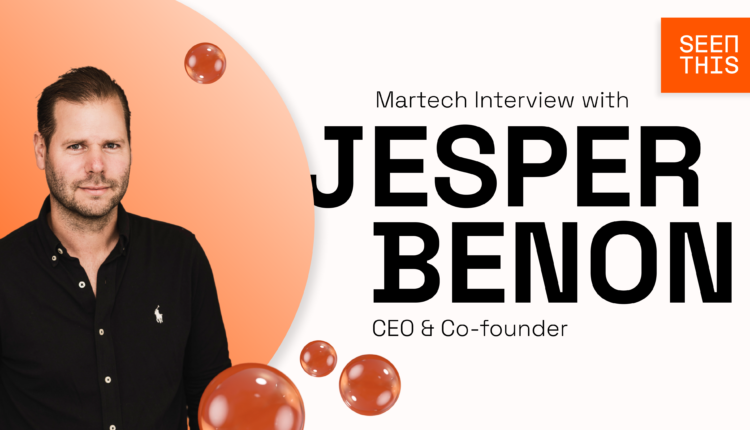MarTech Interview with Jesper Benon, CEO & Co-founder, SeenThis

Jesper Benon, CEO & Co-founder, SeenThis, discusses the changing ad tech landscape and how adaptive streaming is helping brands optimise the customer experience and drive performance in a more sustainable way.
Hi Jesper. Welcome to our Interview Series. Please tell us a little bit about your journey and what inspired you to found SeenThis.
Kristofer Ljungdahl, Marcus Myrberg and I founded SeenThis in 2017. Our journey to founding the company started when a client asked us to place their existing videos in display ad spaces while maintaining the quality of the content. We took on the project and encountered challenges because the ecosystem wasn’t designed to put a streaming video player into a banner ad. However, our hard work paid off and we managed to find a solution, resulting in a 300% CTR uplift in the first campaign.
The client encouraged us to continue with the solution for other campaigns. We realised the key to success was not only high-quality video and low-cost display ad pricing, but the streaming of the creatives, which allowed for faster loading.
So, we switched our business model to combine these aspects – speed and quality – and SeenThis was born.
Tell us what has changed in the ad tech ecosystem over the last three years, and how has the pandemic impacted it?
As a company working at the forefront of the ad tech ecosystem, we have seen the industry undergo massive transformation in the past three years. With historical restraints in the ability to make attractive, engaging creatives, for many years display was only really used to buy cost-effective reach. Branding and engagement KPIs were secondary to this, or in some cases, non-existent.
As video production declined at the start of the pandemic, advertisers sought cost-effective ways to distribute their existing well-produced video creatives. This is where display advertising stepped in, allowing advertisers to prolong the life of a creative by working with different formats, a simple editing process, interactive layers, layouts etc.
What are your core offerings? How do you incorporate advanced technologies to create your products?
SeenThis allows advertisers to deliver high-quality video creatives in the display ecosystem, through either a managed service – where our AdOps team assists in building the creatives – or a self-service studio platform, where clients can build their own creatives, or directly through an API.
Our cutting-edge streaming technology increases attention and performance and benefits end-users with faster load times and less impact on the publisher’s site. And the bonus is that our technology reduces CO2 emissions by minimising data transferred in ad serving, reducing the carbon footprint and benefiting the planet.
Your vision is that you “create a fast internet with a smart footprint” using adaptive streaming technology. Could you define what you mean by adaptive streaming?
Adaptive streaming is a technology that adjusts content delivery according to the end user’s network speed, device and browser, for smooth playback every time. By minimising data transfer while retaining the highest-possible quality content to fit the bandwidth available, we set ourselves apart from the competition and contribute to a more sustainable future.
How do you enable brands to develop performance-focused campaigns?
Load times play a significant role in determining the success of an ad, with a half-second delay potentially affecting metrics such as CTR and CPA. To optimise ad performance, we prioritise both high-quality and fast-loading video ads to drive maximum performance and engagement.
What are the leading industries utilising your platform, and what feedback have you received from your key consumers?
We have not noticed a specific industry adopting our platform, but rather a variety of clients with different KPIs. Initially, our focus was on performance marketing, attracting performance-driven clients.
However, over time we have also seen a significant increase in branding campaigns prioritising quality. Our transparent, pay-as-you-use business model has always been well received and is becoming even more appreciated in today’s economic climate. Our long-standing clients, some of whom have been with us since the beginning, are a testament to the success of our business model.
Do you foresee any challenges for brands as they implement adaptive streaming in mobile advertising?
Adaptive streaming in mobile advertising provides a unique opportunity for brands to create a more personalised experience for users based on their device, browser, and available bandwidth. Adding mobile to the mix means there are more combinations of formats to experiment with. Therefore, the challenge for brands won’t be with the technology itself, but leveraging it to deliver experiences tailored to the user’s conditions – rather than being tempted to use a one-size-fits-all approach.
What is SeenThis doing to address the issue of digital advertising’s negative impact on the environment and contribute to a more sustainable future?
With the pandemic behind us, the frequency and size of conversations around this issue have skyrocketed, and it has now become a top priority for everyone in the industry. In fact, the internet produces just as much, if not more pollution than the aviation industry.
A significant share of today’s data transfer in digital advertising has no impact on user experience. As such, there’s a massive amount of data being transferred that is never consumed or optimised. At SeenThis, we take great pride in being part of the solution to reduce emissions, not only by reducing the volume of data we transfer, but by only serving it for the precise time frame that is being consumed. So nowadays, we are not only optimising our product for speed and quality, but also to make it as data-efficient as possible.
But this needs to be a joint effort. It is time for everyone in the industry to play their part in helping to eliminate data waste as we head towards a more sustainable future.



